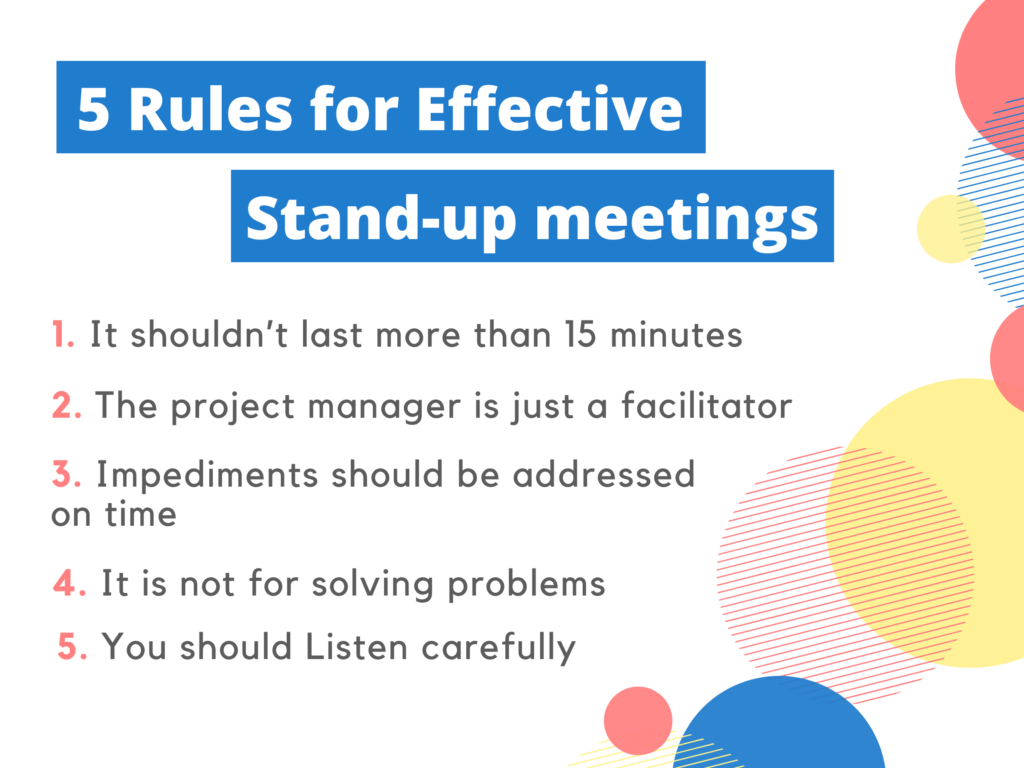The daily stand-up meeting is one of the core events of an Agile project. During these meetings, daily updates are shared and obstacles are addressed, making this type of meeting essential for the project’s success.
How daily stand-up meetings work
During this meeting, each team member shares what they did on the previous day, what they plan to do today, and whether they’re facing any impediments or blockers that they need help with in order to be able to do their work.
Here are 5 key rules for having effective daily stand-up meetings:
1- It shouldn’t last more than 15 minutes
The stand-up meeting should have a short, predetermined duration. A good practice is to dedicate 2 minutes for each participant + 2 more additional minutes, to ensure that the meeting will be straight to the point.
2- The stand-up meeting is not for solving problems
If there are any issues or conflicts, they should be pointed out and discussed after the meeting to make sure all involved parties take part in the discussion and solution.
3- The project manager is just a facilitator
The project manager should not always be the one who manages the meeting, otherwise, it will turn into a status meeting. They should let the team play the main role in the meeting while focusing on removing impediments for them.
4- Listening carefully
Your role as the project manager is to optimize and improve your team’s productivity by allowing them to manage the obstacles they’re facing by themselves. If they were not able to handle these impediments, you should find out why, try to intervene as quickly and efficiently as possible, and document everything so that learned lessons can be captured.
5- Make sure that impediments are addressed on time
It is advisable to keep track of the impediments mentioned during stand-up meetings and how their resolution is advancing. This will give you the needed mechanism to determine if the issues are being handled properly or not.

Here are some trouble signs you should watch out for in daily stand-up meetings:
- Is your team working together or is there tension or a lack of collaboration?
- Are there any risks that may impact future sprints?
- Is there any problem that you can help solve (after the meeting, of course)?
You can get valuable insight into your team’s performance and your project’s overall work progress by attending stand-up meetings. Hence, you should be efficient and vigilant in order to take the necessary action when needed.
Remote Stand-up meetings
If your whole team or part of it is remote, make sure to provide all the necessary tools for running an effective remote stand-up meeting.
Start by choosing a video conferencing platform that is easy to use for everyone, whether they’re logging in using a computer or a mobile device. Make sure your video conferencing platform offers the following features:
- Simplicity: If it takes you 10 minutes to set up your stand-up meeting, you are wasting precious time.
- Screen sharing: Users should be able to effortlessly share their screens from whatever device they’re using.
- Dedicated URL: No one should ever have to type numbers and passcodes on a daily basis. Use a dedicated URL for your stand-up video meetings so people can click to join without much effort.
- Good Video and Audio quality: Everyone should be able to see and hear each other clearly.
Bonus Tips for Effective Stand-up Meetings
- Since daily stand-up meetings are routine in nature, you need to break the routine to keep people engaged. For example, if your typical stand-up meeting agenda includes going around the room clockwise to listen to each member, consider letting a team member choose the next speaker.
- Assign a team member the role of a “timekeeper” to keep the team focused. You can change the timekeeper in each meeting.
- Make sure the meeting always ends on a positive note; ask the team to share their successes no matter how small they are. For example, did the client like what they saw in the last product review? Did a tech team resource successfully overcome a particular issue? Sharing victories is a great way to keep everyone’s mood up and show progress is being made.
We’ve seen how important and useful a 15-minute meeting can be, and now you have everything you need to make sure your stand-up meetings are focused, concise, and effective.
Sample PMP Questions
Question 1
In projects following the Scrum framework, which of the following questions won’t be asked to team members during daily stand-ups?
A. What have you completed since the last stand-up?
B. What will you complete until the next stand-up?
C. What do we need to finish as a team?
D. Are there any impediments?
The correct answer is C. In contrast to flow-based Agile which focuses on the team’s throughput, iteration-based Agile focuses on accountability through three standard questions:
- What was completed yesterday?
- What will be completed today?
- Are there any blockers or impediments?
Question 2
The traditional format of a daily stand-up is to gather in a circle near the relevant task board and each member takes his turn to answer a set of questions. Which of the statements below explains the meaning of daily stand-up in Agile?
A. It is a meeting where the upcoming work schedule is discussed
B. It is a meeting during which the team is asked about what they did on the previous day and their plan for the current day along with any problems they faced during the execution of their tasks
C. It is a daily brainstorming session
D. It is a daily lessons-learned session
The correct answer is B. Daily standup is a meeting held by members of the project team. A daily stand-up meeting is intended to bring the team together for a status update, to ensure that everyone is on the same page and has insight into what is going on, whether it’s good or bad. Such a meeting usually takes up to 15 minutes during which every team member is asked three questions: What did you do yesterday that helped your team meet the Sprint Goal? What will you do today to help your Team meet the Sprint Goal? And, Did you face any impediments that prevented you or your team from meeting the Sprint Goal?
Question 3
What is the Scrum Master’s role during the daily stand-up?
A. Congratulate the team when they do a good job
B. Listen to the team for any faced impediments
C. Ask each team member what they accomplished since the last daily standup
D. This meeting is for team members only, the Scrum Master should not attend
The correct answer is B. During the daily standup, the scrum master listens to the team members for any faced impediments and provides support in case of need. It’s recommended that the standup meeting is facilitated by any team member rather than the project manager to ensure it does not turn into a status meeting. Ideally, it is a time for the team to self-organize and make commitments to each other (Agile Practice Guide, page 54).
Check out the Scrum Cheat Sheets to learn more about Scrum’s other events and ceremonies and how to appropriately implement this framework.
